Pav bread is very much in demand in the Indian fast-food scene. These are very similar to soft dinner rolls. There are many different ways to make these buns but usually it is made with white flour, with or without diary. This recipe uses milk and makes a very spongy delicious pav. Egg Free
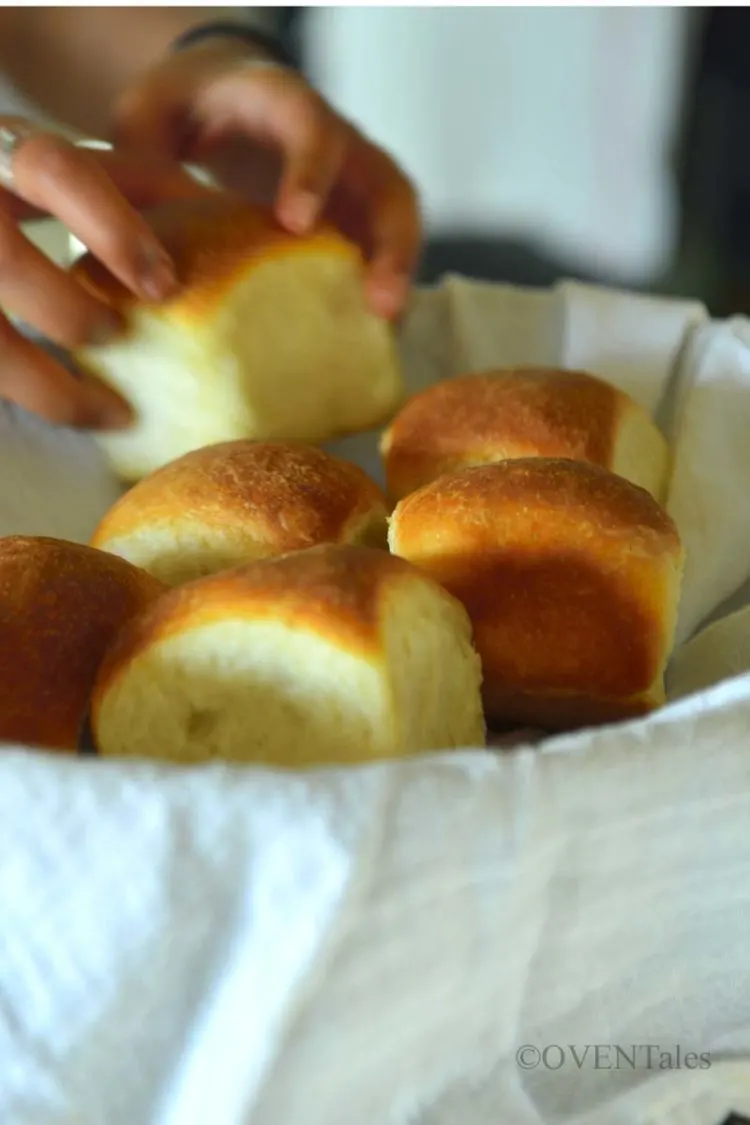
This is pav – a popular bread in the Indian fast food scene. This bread is the star in various dishes – there is Vada Pav with a potato fritter and slathered in various chutneys, Pav Bhaji with a side of spicy vegetable mash, Kuchi Dabeli with boiled potatoes and sweet and spicy dabeli spice mix, Misal Pav with sprouted bean curry, and many more that are local variations.
These are all easy to serve dishes and can be fairly easy to eat while standing at the street corner with a bag hanging on your shoulder waiting for the next train/bus to come. That said these taste better when enjoyed with company.
What is Pav
Pav is bread, specifically Indian dinner rolls. It is soft and spongy with a well-browned thin but defined crust. It is considered vegetarian and made without eggs, but dairy is an acceptable addition. There is a light taste of milk and a touch of sweetness to this bread. These flavors make it stand up to spicy curries and the various chutneys that are part and parcel of the Indian fast food (chaat) scene.
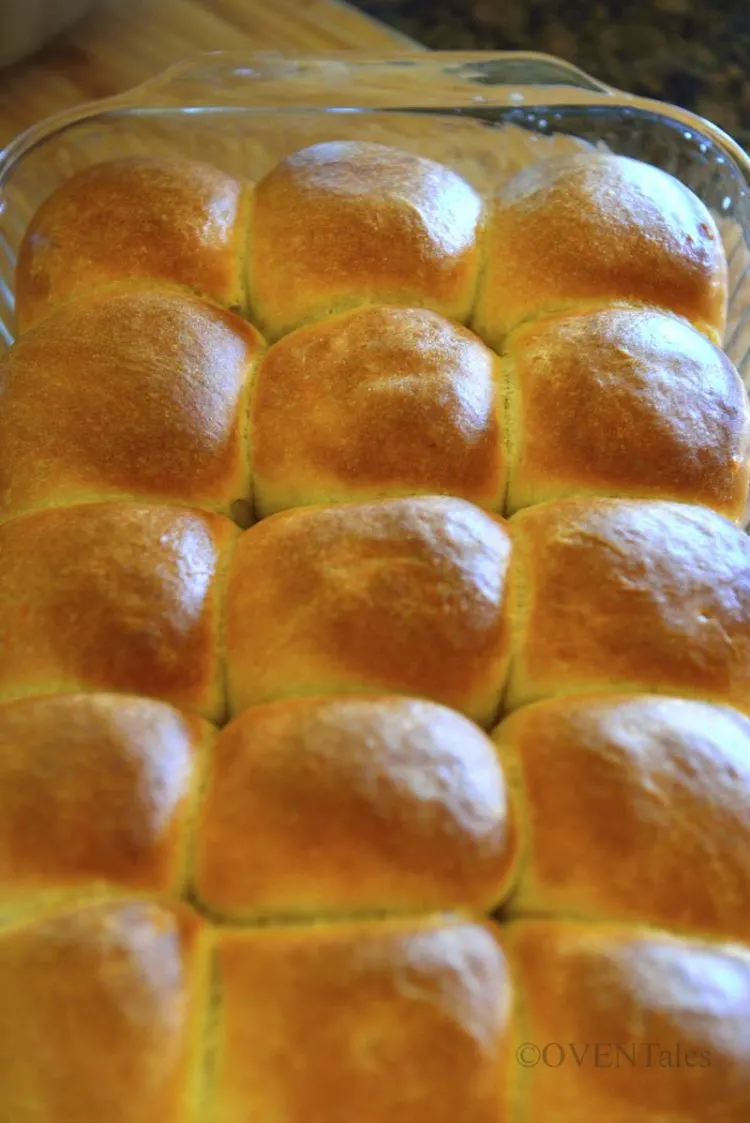
The commercially made ones have dough improvers and other additives like fungal inhibitors. When I make Pav in large batches I use a version with Tang Zhong or hot water (Yudane) method, which helps the bread stay fresh for 2 to 3 days without any chemical additives. More on that another day.
Ingredients
Here is a list of ingredients and a short note on each
Flour
All-purpose flour with good protein content or flours labeled as bread flour works for this recipe. If you think the protein content is low add 1 to 2 tbsps of vital wheat gluten per batch of the recipe. These can be made with whole wheat flour too. Substitute up to 50% of the four with whole wheat, but use fine ground whole wheat. Whole wheat tends to absorb more moisture and the bread could turn out to be denser. I prefer to use unbleached and un-bromated flour.
Yeast
Yeast is the leavening agent here. The recipe is written with active dry yeast in mind. It is important to make sure that the yeast you have is active as this could make or break the bread. So discard and start over with a new batch if bubbles do not form as expected.
Milk
Milk is the secret to the tenderness of this bread. You can add additional milk powder, but I find that using whole milk is better than adding extra milk powder.
Butter
Butter helps the bread stay soft and moist – both from the inside and outside. Brush the tops of the buns with butter soon after they are baked. This gives it a nice sheen and helps the crust prevent drying out.
Salt and Sugar
Salt is necessary to strengthen gluten as well as taste. So do not skimp on that. A little sugar in the recipe is for feeding the yeast. You can reduce or increase the sugar a little per your taste. The way it is written the bread is ever so slightly sweet.
How to Make Pav Buns
Making Pav is like making any sandwich loaf. Make sure that the yeast is active and knead well to develop gluten. Try to get the flour with the highest protein content or add 1-2 tablespoons of extra gluten per batch of the recipe.
The recipe starts by activating the yeast. Mix 1/4 cup warm milk, heated to 110°F or just warm to touch, with 1 tablespoon sugar. Stir well to dissolve the sugar. Sprinkle the yeast on top and let it sit undisturbed for 5 to 10 minutes in a warm environment. If the yeast is active you will be seeing bubbles on the surface as in the picture.
Mix the flour, salt, butter, and milk to the yeast solution and knead for 10 to 15 minutes until a soft pliable dough is formed. As you knead you will feel the texture of the dough change. From a rough mass to a smooth mix a ball to a pliable mix that has an ever so little ‘give’ when made into a ball.
You could do this in a mixer as well. 3 to 4 minutes of kneading in the mixer will be enough to get the dough in the right consistency. Shape the dough into a ball and place it in an oiled bowl. Cover and let it rest in a warm environment for about 1 hour or until it doubled in size.
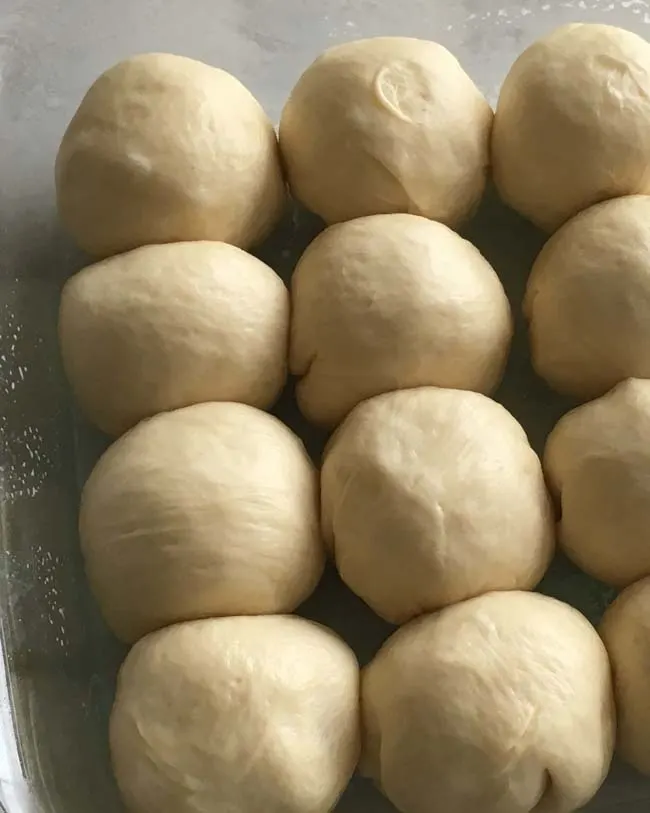
Shape and arrange 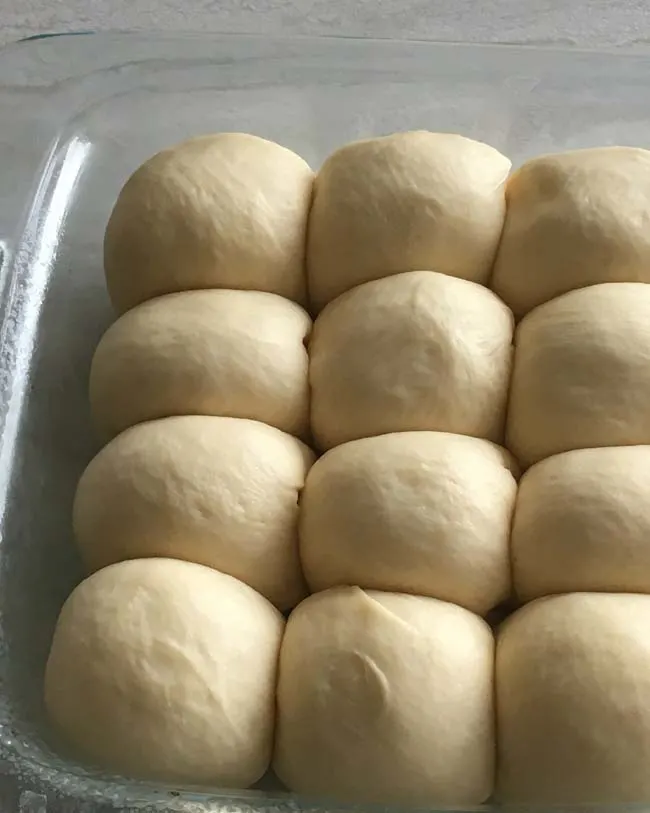
After rising
Punch down the dough and knead gently a few times. Divide it into 12 equal-sized pieces and form each piece into a ball. Place in an oiled pan. Cover and let it rise for 20 to 30 minutes in a warm area. The dough balls should almost double in size. Allowing it to further increase in size will weaken the gluten strands leading to the buns collapsing while in the oven.
If they are overrisen, mix all the pieces t and knead for a minute. Afterwards divide and shape as above. This is possible only the first time. If it over proves again it is better to make flatbread with it as in this easy flatbread.
While the shaped buns are rising preheat the oven to 375°F (190°C). Brush the tops of the buns with butter and bake for 20 mins. Remove from the oven and brush the tops again with butter. This will help the crust from drying out. Cool in the pan for 10 minutes and transfer to a cooling rack to cool completely.
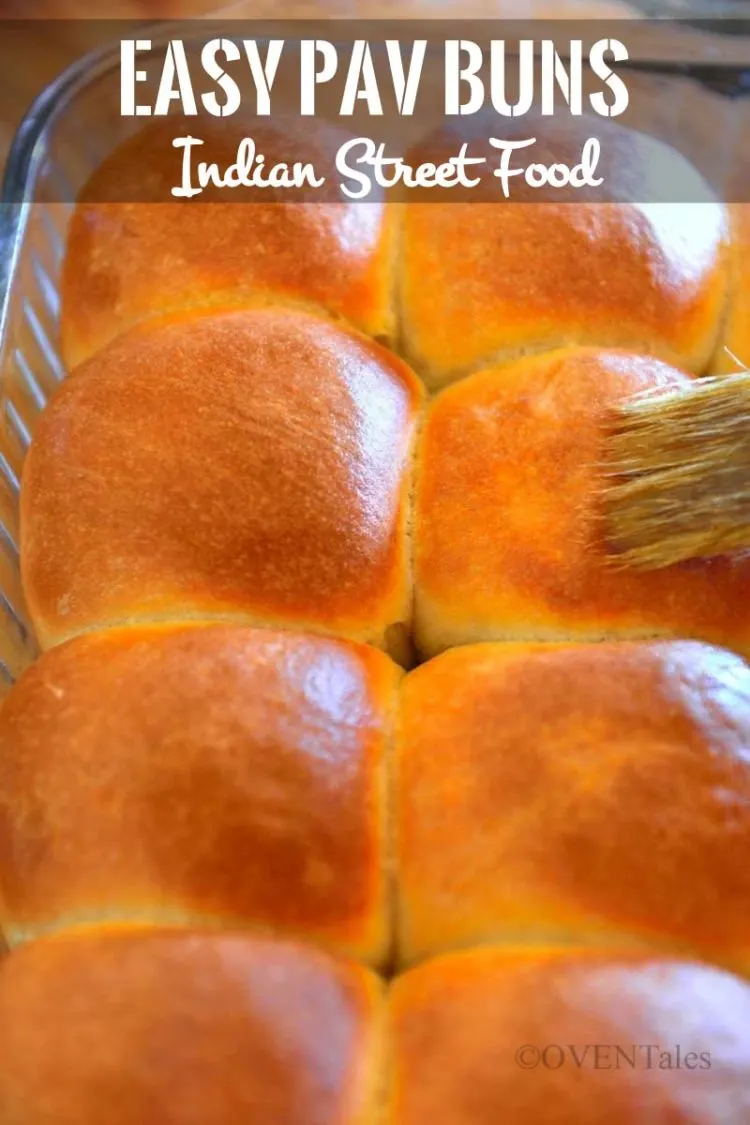
Storing
Homemade bread tastes when consumed on the same day. It will lose some of it freshness after one day. For longer storage it is best to freeze bread. On the other hand the store bought loaves of bread stays fresh for days and even weeks. Use the Tang Zhong method or kneading part of the dough with hot water (Yudane) to keep the bread soft and fresh for up to 3 to 5 days without the use of any chemical additives.
In any case, store the cooled bread tightly covered. If freezing break into individual rolls and store in freezer-safe bags.
Similar Breads
A large number of Indian population is vegetarian and many avoid eggs in their diet. So Pav is made without eggs to cater to everyone. But if eggs are not an issue for you try this no-knead dinner roll recipe. It is much easier to make and has a similar taste.
The recipe can be made into a loaf and conversely, your favorite loaf recipe can be made into a roll as well. If doing so, increase the cooking time to convert to a loaf and decrease it when converting to rolls.
With that in mind, Kaiser rolls and whole Wheat Buttermilk Bread are other recipes to try.
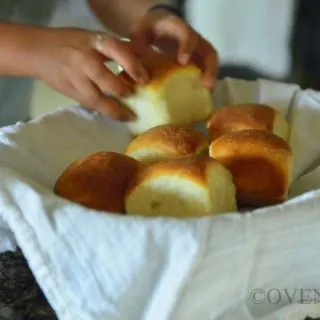
Easy Pav Buns
Ingredients
- 3 C Flour 350g
- 1 C Milk 240g
- 1 Tbsp Sugar 15g
- 2 1/4 Tsp 1 pkt Active Dry Yeast (7g)
- 1 Tsp Fine Sea Salt 7 g
- 3 Tbsp Butter
Instructions
- Warm the milk to 110°F or just warm to touch. Take 1/4 C of the milk and mix in 1 tbsp of sugar. Sprinkle the yeast on top and set it aside for 5 to 10 minutes in a warm place. By then the yeast should activate the milk should be frothy.
- Take the flour and salt in a large bowl. Make a well in the center of the flour mix and pour in the activated yeast mix. Slowly mix in the flour adding the remaining milk as needed to bring all the flour together. Add 2 tablespoons of the softened butter and knead for 10 to 15 minutes until the dough becomes soft and pliable.
- Take a large bowl big enough to hold the risen dough (about 3 times volume of the dough to give some headroom). Lightly coat the insides of the bowl with oil. Form the dough into a smooth ball and place it in the oiled bowl. Cover and let it rise in a warm place until it has doubled in volume, about 1 hour.
- Uncover and punch down the dough. Divide into 12 portions and form each portion into a smooth ball.
- Take an ovenproof container and arrange them side by side so that they just touch each other. Cover and let rise till almost doubled, about 20 to 30 minutes.
- Preheat the oven to 375°F (190°C). Melt the remaining 1 tablespoon of butter and lightly brush the tops of the risen buns. Transfer to the oven and bake for about 20 minutes till the tops are browned.
- Remove from the oven and brush the tops with more butter. Let cool in the pan for 5 minutes before transferring to a cooling rack to cool completely.
- If not using within a day, wrap and freeze the rolls individually.
Notes
- The volume measurements are approximate and tend to change a little depending on the flour and how it is measured. Weighing gives more predictable results.
- Water can be used in place of milk, but the bread will not be as tender.
- When adding milk to knead rely on the feel of the dough to determine the amount of water/milk required. This is especially important when measuring by volume.
Nutrition
Important: Nutrition Values are estimates. Actuals vary based on ingredients and serving size.
Recipes You Might Like
Happy Cooking !!!


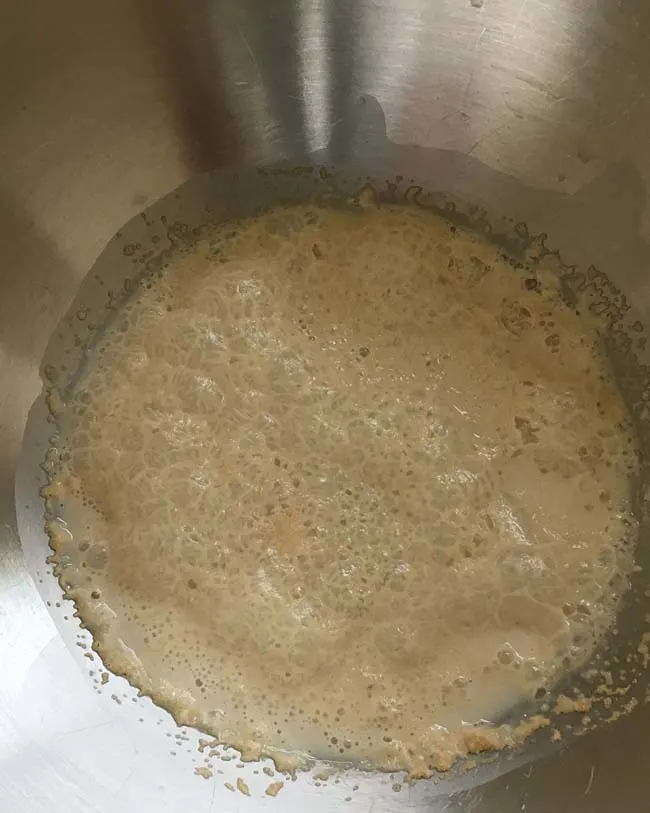
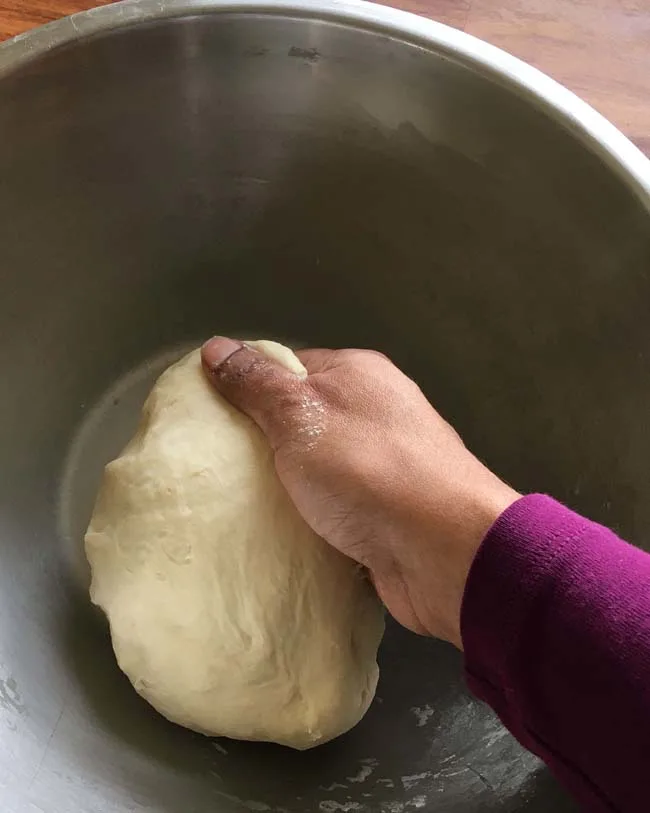
Lokesh meena
Wednesday 26th of September 2018
Yammy I wud like to make mouthwatering.
Syama
Sunday 30th of September 2018
Thank you! I would love to hear about when you make it !!!
Jose Wilame Araujo Rodrigues
Sunday 22nd of October 2017
Hey very nice blog!|
Malissa
Monday 18th of September 2017
Good information. Lucky me I came across your blog by accident (stumbleupon). I have book marked it for later!
Abe
Sunday 3rd of September 2017
Thanks for sharing your thoughts about bread. Regards
ig
Wednesday 2nd of August 2017
Hi there, I wish for to subscribe for this webpage to get most up-to-date updates, therefore where can i do it please help out.
Syama
Wednesday 2nd of August 2017
Thank you for your interest! You can follow me on any of the social feeds on the side bar to get the latest updates - Pintrest, Facebook , Instagram, Google or via blogloving or rss feeds.